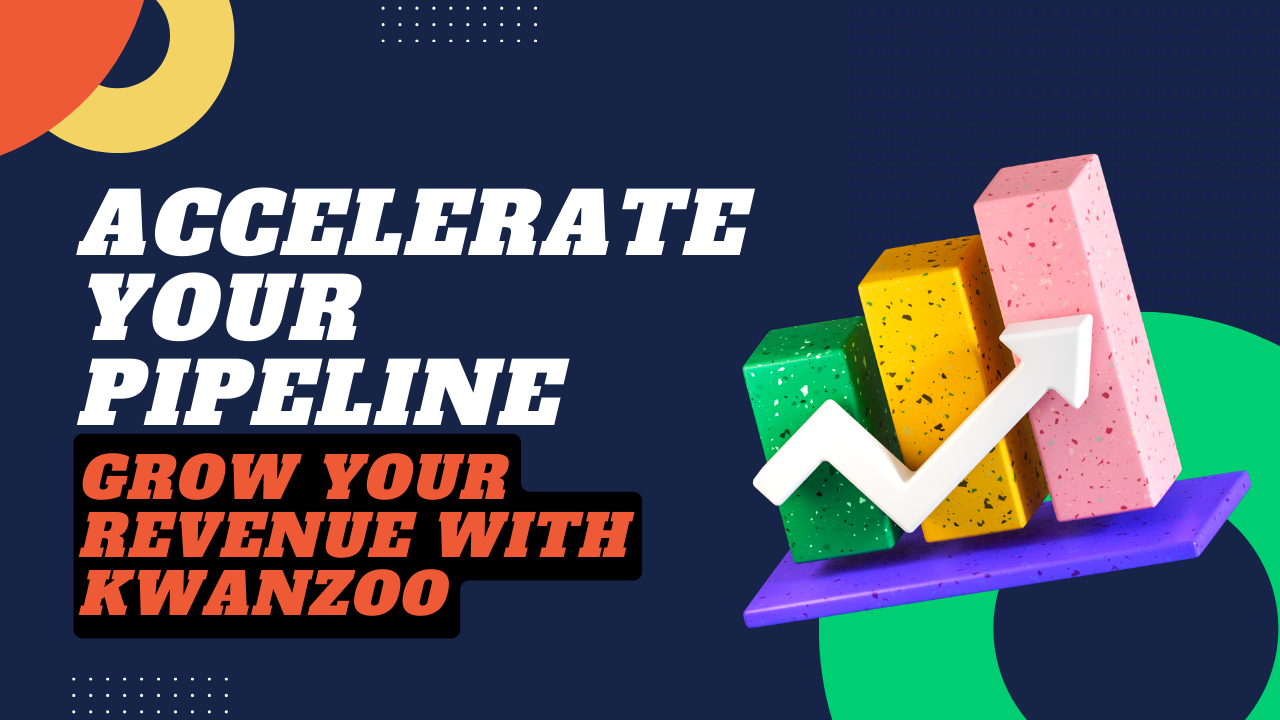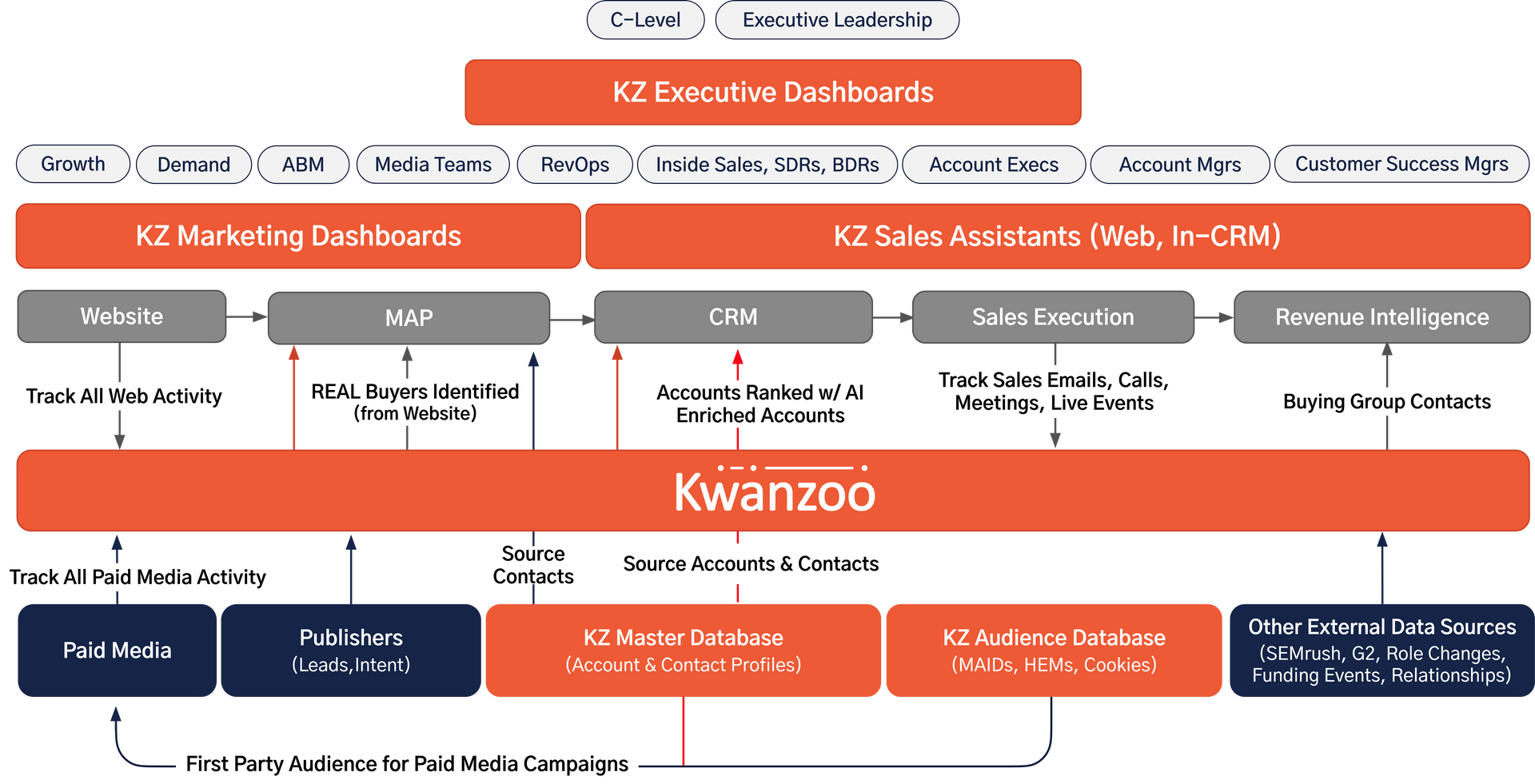
Driving growth at B2B companies is increasingly a challenging endeavor. It’s harder than ever to gain the attention of prospects, get them to learn about your solution offerings, and have your business under consideration when they are ready to buy. Your SDRs and Sales teams often lack enough actionable insights around companies or buyers that are in-market, and ready to engage. Addressing all of this requires a strategic approach to marketing and selling, that integrates cutting-edge technology, with actionable data and insights.
At Kwanzoo, we understand the challenges B2B businesses face in scaling their pipeline and revenues. Our innovative B2B pipeline growth platform is designed to simplify and unify the pipeline development process across your entire go-to-market (GTM) tech stack. Let’s explore how Kwanzoo can empower your sales and marketing teams to accelerate the growth for your business.
Grow Your Revenue with Kwanzoo
Kwanzoo’s Buyer Identity Resolution: We're not just another AI platform. We are the first to market to introduce unique technology that allows us to identify real buyers, not just the companies that visit your website. Our unique approach ensures you connect with warm prospects who are already leaning in, leading to more meaningful conversations and conversions. Learn more about how Kwanzoo’s cutting-edge technology can transform your outreach strategies.
Unified Intent for Actionable Insights: Kwanzoo combines buying signals from multiple intent data sources, making it actionable for your Sales Development Representatives (SDRs) and sales teams. With Kwanzoo, you don’t just get data; you get insights that drive results. Learn more about how Kwanzoo’s unified intent can elevate your outbound sales strategies.
Single Pane of Glass: Kwanzoo offers a consolidated view of your data through our Single Pane of Glass features. With a built-in Data Warehouse, 167+ connectors to integrate data, and rich customizable visualizations, our platform delivers insights from C-Level leaders to frontline representatives. Let us help you get exactly the right insights in front of each of your teams, to ensure strong marketing and sales alignment around your go-to-market efforts. Learn more about how Kwanzoo can provide a holistic view of your B2B pipeline development.
The Backbone Platform for B2B Pipeline Development

Kwanzoo serves as the backbone platform to integrate all your data and tools for B2B pipeline development. Our Account-based platform supports key stakeholders across marketing, sales, and customer success. Here’s what Kwanzoo can do for you:
Identify and Prioritize the Right Buyers: Kwanzoo helps you identify and prioritize the right buyers for your sales outreach efforts. We provide net new buyers with real buyer identities directly from your website, buyers verified across multiple email sources, and buyers ranked for high value based on their interactions with your site.
Prioritize the Right Accounts with Buying Signals: We go beyond basic account ranking. Kwanzoo offers deeper buying signals, including site location, division, and project details. Our platform verifies accounts for the correct name, domain, revenue, industry, and more. With Kwanzoo, you can measure the influence of accounts with buying signals on your pipeline growth.
Fill Your MAP and CRM with Quality Data: Kwanzoo ensures your Marketing Automation Platform (MAP) and Customer Relationship Management (CRM) system are filled with the right account and buyer data. We provide all the account and contact data you need for your Ideal Customer Profile (ICP) accounts, with monthly data refresh, and complete records for all the data provided, saving you up to 80% on data costs.
Reach and Engage Buyers Effectively:
Kwanzoo enables you to serve 1:1 targeted display ads to specific buyers and accounts. Compare and optimize message themes to achieve optimal outcomes. Our platform offers 20% lower media costs compared to other market players and 4X-5X lower media costs compared to LinkedIn ABM Ads. Our ad targeting uses our own first party audience data, which when combined with our unique buyer resolution technology, delivers significantly higher (> 30%) buyer resolution on your website. That’s more actionable data for your SDRs. With Kwanzoo, you can measure the impact of your ad spend on pipeline and revenue.
Gain Insights for Informed Decision-Making: Kwanzoo provides a single pane of glass view across marketing, sales, and customer success. With 167+ connectors to GTM platforms and tools, account-based (ABM) and impact dashboards for all users, and the ability to connect to Product Usage, Finance, and other systems, our platform offers comprehensive insights for informed decision-making.
Kwanzoo empowers your business with the tools, insights, and strategies needed to accelerate your pipeline and grow your revenues.
Experience the Kwanzoo advantage today and transform your B2B growth journey.

There are common misconceptions about the difference between ideal customer profiles and buyer personas, and understandably so. They have similarities in that they both include a set of guidelines your teams can use to qualify leads. Where you'll see a difference is how and when you use them. Do you need both an ideal customer profile and buyer personas? Let's break it down and figure out where to start.
What is an Ideal Customer Profile?
An ideal customer profile (ICP) serves as a blueprint for identifying the perfect customer for a business. It becomes particularly valuable when implementing account-based marketing (ABM), allowing organizations to concentrate on selling to targeted accounts that align with their objectives.
Crafting an effective ICP involves understanding the problems the organization solves, aligning product or service capabilities with customer needs, and outlining a roadmap for future updates and enhancements.
Sending every lead to sales isn't efficient because not all leads are a good fit. Defining the characteristics of an ideal customer helps in distinguishing between leads likely to convert and those less likely to do so. Key considerations include budget, industry, geography, legal restrictions, and product/service limitations.
However, ICPs primarily focus on account fit rather than individual characteristics. Once suitable accounts are identified, attention shifts to understanding the specific stakeholders involved in the purchasing process.
This non-exhaustive list provides a starting point for identifying ideal customers and ensures that sales efforts are directed towards leads that are most likely to convert:
Budget / Revenue / Company Size - what is the lowest cost threshold that a customer would have to pay for my product or service?- Industry - are there specific verticals that I work within? Are there verticals that I don't work with?
- Geography - do I not sell to a particular region?
- Legality - are their legal reasons that limit my potential customer base, maybe age, location, or government restrictions?
- Product or Service Limitations - do I have a service level agreement (SLA) with my customers to meet a certain response time? If someone needs a response quicker, can I guarantee I'll be able to meet that demand?
This is a non-exhaustive list but a great starting point when trying to identify what my ideal customer looks like. These are the qualities that a lead needs to have to be able to buy from me. If they don't meet all of these predefined characteristics, I can disqualify them and ensure my sales reps are spending time with leads that are a good fit.
ICPs are focused on the fit of the account and don't dive too deep into the individuals I will encounter. Once I identify accounts that fit my ICP, I want to start thinking about who my sales reps are talking to and who is responsible for actually making the purchase.
How do I find quality leads?
The key to successful sales is starting with quality leads. Quality leads are potential customers who are more likely to buy from you, and focusing your outreach on these leads can significantly improve your conversion rates. Here’s how to find and target these leads effectively:
- Define Your Ideal Customer Profile (ICP): Begin by clearly defining your Ideal Customer Profile (ICP). Your ICP is a detailed description of the type of company that would benefit most from your product or service. Consider factors such as industry, company size, location, and revenue. Identifying these characteristics will help you target your marketing and sales efforts more precisely.
- Utilize Data-Driven Tools: Use data-driven tools and platforms to identify companies that fit your ICP. These tools analyze various data points to provide you with a list of high-potential leads. By leveraging such technology, you can focus your efforts on leads that are more likely to convert, saving time and resources.
- Develop Buyer Personas: Once you have identified potential accounts, it’s crucial to understand the individuals within these accounts. Buyer personas are semi-fictional representations of your ideal customers based on market research and real data about your existing customers. Define personas for different roles within the target companies, considering their titles, product/service knowledge, and levels of experience.
What is a Buyer Persona?
A buyer persona is a semi-fictional, generalized representation of your ideal customers. These personas account for various factors such as demographics, goals, motivators, and challenges they face. By developing buyer personas, your organization gains structure and context that are essential for tailoring your marketing, sales, and support efforts.
Importance of Buyer Personas
Buyer personas provide a framework that helps your organization understand and relate to your customers better. They enable your marketing team to map out and curate content that resonates with your target audience. Additionally, personas help sales and support teams allocate their time and resources more efficiently, ensuring a consistent and targeted approach across all customer interactions.
Creating Effective Buyer Personas
Most companies benefit from having two to five buyer personas. It's a common mistake to create a separate persona for each job title your team interacts with. Instead, focus on the different challenges and needs of your audience. For example, instead of creating personas like "Marketing Manager Mary" or "Sales Rep Sam," consider personas such as "Recent Grad Rachel," "Tech-Savvy Tom," or "Start-up Steph." These personas shift the focus from job titles to the day-to-day challenges your customers face and how your product or service can solve these problems.
Steps to Define Buyer Personas
- Identify Challenges and Solutions: Focus on the specific challenges your personas encounter and how your product or service can provide solutions. This approach helps you understand their pain points and the information they seek during the buying process.
- Understand Information Consumption: Consider how each persona consumes information and what their ideal buying process looks like. This understanding allows your teams to adjust their communication strategies effectively.
- Conduct Market Research: Buyer personas should be based on thorough market research and real data from your existing customers. Utilize insights from various sources within your organization to create accurate and useful personas.
Gathering Insights for Buyer Personas
- Customer Feedback: Engage with your current customers to gather insights. Pick up the phone, send surveys, or host focus groups to identify their motivators, challenges, and favorite aspects of your product or service. Additionally, speak with customers who aren't a perfect fit to understand which characteristics to avoid targeting.
- Internal Team Interviews: Interview customer-facing teams such as sales reps and customer success managers. These teams interact with your customers daily and can provide valuable insights into common questions, challenges, and roadblocks your customers face.
- Analyze CRM Data: Use your CRM to identify trends and better understand how your leads are accessing and consuming your content. This data can reveal important patterns and preferences among your target audience.
Implementing Buyer Personas
Once you have defined your buyer personas, share them internally to ensure alignment across all teams. For organizations using tools like Kwanzoo, integrate your personas into the platform for seamless implementation. If you're not using such tools, create a comprehensive document or PDF to distribute within your organization, ensuring everyone knows who your target customers are and what challenges you are solving for them.
Do I Need Both an Ideal Customer Profile and Buyer Personas?
Absolutely! Having both an Ideal Customer Profile (ICP) and buyer personas is essential for effective marketing and sales strategies, especially in the IT and SaaS sectors. While they serve different purposes, they are closely linked and work together to streamline your efforts.
Understanding the Ideal Customer Profile (ICP)
Your ICP is a detailed description of the type of company that would benefit most from your IT or SaaS product or service. It includes specifics such as industry, company size, location, and revenue. The ICP helps your organization identify and prioritize which accounts to target, ensuring your sales team focuses on leads with the highest potential to convert.
Example: Solar Boost's ICP (adapted for IT/SaaS)
- Industry: Technology companies, particularly those in renewable energy or sustainability sectors
- Company size: 50-200 employees
- Location: Urban areas with high potential for adopting tech innovations
- Revenue: $10M-$50M annually
- Technology Stack: Companies using cloud-based solutions and modern tech stacks
What are Buyer Personas?
Buyer personas are semi-fictional representations of the key individuals within those target companies. They include details about demographics, goals, motivators, and challenges. Buyer personas help your marketing team create relevant content and guide your sales team in effectively communicating with different stakeholders within a target account.
Example: Solar Boost's Buyer Personas (adapted for IT/SaaS)
- Tech-Savvy Tom: IT Manager focused on integrating new technologies to improve efficiency.
- Cost-Conscious Chris: CFO concerned with the ROI and cost savings of new software implementations.
- User Experience Ursula: Product Manager looking for tools that enhance user experience and streamline operations.
How ICPs and Buyer Personas Work Together
- ICP for Targeting: Use your ICP at the beginning of the sales cycle to qualify leads. This ensures your sales reps focus on accounts that fit your criteria, saving time and resources.
- Buyer Personas for Engagement: Once leads are qualified, buyer personas help tailor your approach. They provide insights into the challenges these individuals face and their content consumption habits, enabling more effective communication and engagement.
Continuous Improvement
It's essential to periodically update and refine both your ICP and buyer personas. As your business evolves, so does your understanding of your customers. Review and revise these definitions annually, and keep your teams informed of any changes.
Conclusion
Defining both your ICP and buyer personas ensures that:
- Sales focuses on high-potential leads.
- Marketing creates content for the right audience.
- Support is equipped to answer relevant questions.
In the IT and SaaS sectors, this strategic alignment is crucial. Investing time in defining your ICP and buyer personas upfront can lead to significant long-term benefits by aligning your entire organization towards targeting and engaging with the most suitable customers. This alignment ensures that your marketing, sales, and support teams are all on the same page, working together to attract, engage, and retain the right customers
Mani Iyer • June 14, 2024


